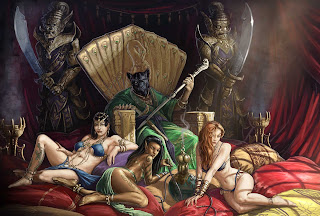Become the Steel
Transmutation
Level: Cleric/Oracle 6
Components: V, S, F (weapon; see below), DF
Casting Time: 1 immediate action (see below)
Range: Personal
Level: Cleric/Oracle 6
Components: V, S, F (weapon; see below), DF
Casting Time: 1 immediate action (see below)
Range: Personal
Target: You
Duration: Instantaneous
Saving Throw: None
Spell Resistance: No
Duration: Instantaneous
Saving Throw: None
Spell Resistance: No
This secret spell is given only to the most
favored servants of the deities of war, so that they can continue to serve
until the end of times. When the war priest is fatally wounded, he can cast become the steel as an immediate action.
As life leaves his body (if any remains), the
caster’s spirit is transported to his holy weapon, powering it.
After casting become the steel the cleric effectively turn into a new character – a unique intelligent magic item. To determine the weapon’s
characteristics, build the item using the PC entry from the Character Advancement and Level-Dependent Bonuses table. For example, as 12th level cleric using become the steel would turn into an
intelligent magic weapon with a cost of 108,000 gp.
Become the steel requires as focus either a magical
or a masterwork weapon. The chosen item must also be the deity’s favored weapon.
This is a domain
spell; actually a War Domain spell. This means that only clerics with the
Domain of War (or oracles with the Battle Mystery) can cast ask for this spell.
However, if another cleric find this spell in scroll form, he can add
it to his spell list by meditating and making the proper sacrifices and rituals
(and paying the same cost of wizard writing a new spell in his grimoire; this
costs cover incenses, expensive herbs, ritual instruments and special holy
symbols etc.). War clerics (and Battle Oracles) will try to kill “the heretic”
for stealing their secrets.
This spell is also the
type of dweomer that I love to find in fantasy RPGs – weird and of dubious
utility at first (definitely not a ‘gamey’ spell), but also potentially awesome
in its dramatic consequences. Imagine if the most powerful weapons of the
scenario actually house the souls of the greatest war priests? I would even let
a PC continues to play with his character (now a magic weapon), maybe with his
Cohort wielding “him”. As always, the GM must forbid any abuses from the
players – specially “suicide” PCs that want a “cheap” way of creating potent
magic items (the GM is encouraged to remove the spell or the make each new
intelligent a NPC with its own agenda – probably alien and contrary to the party’s
plans).




